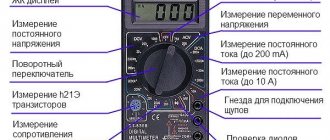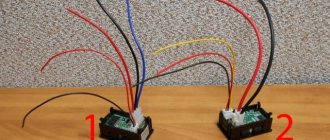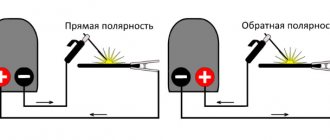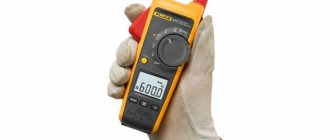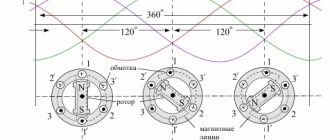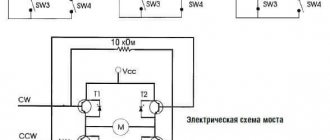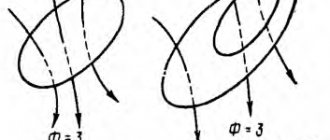Many people remember Ohm's law from school physics : the current strength in a circuit is directly proportional to the voltage and inversely proportional to the resistance.
CURRENT STRENGTH is a quantitative characteristic of electric current - it is a physical quantity equal to the amount of electricity flowing through a cross-section of a conductor per unit time. Measured in amperes.
For electrical wiring in an apartment, the current strength plays a huge role, because based on the maximum possible value for a separate line coming from the electrical panel, the cross-section of the conductor and the value of the maximum current of the circuit breaker that protects the electrical cable from damage in the event of a short circuit or overload currents depend.
Therefore, if the cross-section and circuit breaker are not chosen correctly, it will simply be knocked out, and replacing it with a more powerful one will simply not work.
For example, the most common wires and cables in electrical wiring with a cross-section of 1.5 square millimeters are made of copper or 2.5 square millimeters of aluminum. They are designed for a maximum current of 16 Amps or a power connection of no more than 3 and a half kilowatts. If you connect powerful electrical consumers exceeding these limits, then you cannot simply replace the circuit breaker with a 25 A one - the electrical wiring will not withstand it and you will have to transfer a copper cable with a cross-section of 2.5 sq. m from the switchboard. mm, which is designed for a maximum current of 25 A.
Measuring current in electrical networks
Current strength is measured in amperes and characterizes the load on electrical networks. The need to measure current arises to check whether the load on the cable is acceptable. Cables of various sections are used for installation of electrical wiring. Permissible currents for cables with polyvinyl chloride insulation laid over the air are:
| Core cross-section, mm2 | Aluminum conductors in quantity | Copper conductors in quantity | ||||||
| 2 | 3 | 4 | 5 | 2 | 3 | 4 | 5 | |
| 1,5 | 24 | 21 | 20 | 20 | ||||
| 2,5 | 25 | 21 | 20 | 20 | 33 | 28 | 26 | 26 |
| 4,0 | 34 | 29 | 27 | 27 | 44 | 37 | 34 | 34 |
| 6,0 | 43 | 37 | 34 | 34 | 56 | 49 | 46 | 46 |
If the cable line load exceeds the permissible limit, the cable will heat up and its insulation will be destroyed. As a result, this will lead to a short circuit, and the cable will have to be replaced with a new one.
Therefore, after replacing the cables, measure the current flowing through it when connecting all electrical appliances. If the electrical wiring is old, then when connecting an additional load to it, you also need to check whether the currents in it correspond to the permissible values.
When the electrical wiring is under maximum load, you can check whether the current through the circuit breakers corresponds to their rated data. If the rated current of the machine is exceeded, its operation due to overload is inevitable.
Measuring current is required to determine the operating modes of electrical appliances.
note
Measurement of load currents of electric motors is carried out not only to monitor their serviceability (currents in all phases must be the same), but also to determine the presence of overload due to increased torque on the shaft.
For a heater, measuring the current will show whether all its heating elements are working properly. Only by measuring the load current can you find out whether the heated floor is working.
Electric current power
Power is the work done by electric current per unit time. It is measured in Watts (W, W).
It is theoretically possible to measure power directly, but for this purpose special devices are used - wattmeters, which measure the current through the load and the voltage across it. They give readings in Watts, but connecting them is too difficult.
Therefore, they are used for measurements at predetermined nodes of the electrical network, connecting to them once and for all.
Panel wattmeter for measuring current
For domestic use, the power is calculated after measuring the current consumed by the load and the voltage across it, which for simplicity can be taken equal to 220 V.
This method does not always give accurate results. When there is inductive reactance in the load, the active power is affected by the power factor.
Some electrical appliances consume non-sinusoidal current (LED and energy-saving lamps, computer and television equipment), which not all measuring instruments designed to measure alternating voltage measure correctly.
Instruments for measuring current strength
You can measure current using the following instruments:
- ammeters . Like wattmeters, they are used for stationary measurements.
Current measurement: panel ammeters
— multimeter – a multifunctional device with a digital liquid crystal display (how to use a multimeter?);
Current measurement: multimeter with clamp meter
- tester - a device that measures several quantities, but, unlike a multimeter, has a dial indicator;
Current measurement: tester
— current clamp - a device that allows you to measure current without breaking the electrical circuit.
Current measurement: clamp meter
Current measurement methods
Unlike measuring voltage, current is measured not when the device is connected in parallel to the load, but when connected in series. This means that the measuring device must be connected to the break of any of the power wires of a single-phase consumer.
With three-phase power, the same must be done for each phase. In this case, the current in the neutral wire is not measured, since with a symmetrical load it is zero.
Sometimes it is necessary to measure the current in the neutral conductor, but for a group of consumers, disconnecting the neutral to make measurements is impossible.
Connecting an ammeter when measuring current
All these reasons lead to the fact that testers and conventional multimeters are rarely used to measure current. They can only be used for a single consumer or for DC measurements.
In all other cases, current clamps or multimeters containing them are used. To take measurements, simply press the key to release the clamps, place the conductor with the current being measured inside the measuring circuit, and release the key. The magnetic circuit of the clamps will close and the display (there are clamps with a scale and arrow) will show the measured value.
When using current clamps, you need to carefully ensure that only the conductor in which the current is measured gets inside the magnetic core.
When two or more conductors get inside, the clamps will measure the sum of the currents in them, and also the vector one. This means that by placing a two-core cable with a load inside the magnetic core of the clamp, we will measure a current equal to zero.
Clamps, like an RCD, will add up the current flowing through the phase conductor towards the load and the same current with the opposite sign returning back.
Important
Clamps are intended for measuring alternating current only. At direct current, an attempt to use them will lead to the magnetic circuit closing with an irresistible force. It will not be possible to open it with your hands until the current is turned off.
Source: https://electric-tolk.ru/izmerenie-sily-toka-v-elektricheskix-setyax/
How to measure current in an electrical circuit with an ammeter yourself
For what purpose might it be necessary to measure current strength? What is the benefit to us from knowing the number of charged particles flowing through a unit cross section per unit time? There is a benefit, and the value of this information is great!
By using only an ammeter, you can quickly determine the correct installation and avoid the costs of replacing or repairing damaged electrical equipment. The ammeter reading will tell you whether there is a short circuit or other leaks or problems in the circuit. Knowing the current consumption will not be superfluous when choosing a particular fuse.
Current characteristics
Direct current is characterized by two main parameters - current and voltage. Current strength is simply the number of particles that move in a conductor in a certain direction. The more of these particles, the greater the work done by the electric current.
Current strength is measured in amperes (you need to know that a microamp is one millionth of an ampere, a milliamp is one thousandth of an ampere).
The current strength is measured with an ammeter. The ammeter must be connected in series with the current collector.
In addition to direct current, there is alternating current. Alternating current changes its direction and amplitude over time. Electricity generators produce alternating current. Alternating current changes over time according to a sinusoidal law. To characterize it, there are additional parameters - amplitude and frequency.
Principle of operation
The first device was invented by Schweiger at the beginning of the 19th century, but it was then called a galvanometer. A drawing of a simple ammeter looks like this. On the axis of the bracket there is a steel anchor with an arrow. This structure is located parallel to a permanent magnet, which acts on the armature and gives it magnetic properties.
Lines of force run along the magnet and the arrow, which corresponds to the zero position on the scale. As soon as electric current begins to flow through the bus, a magnetic flux will be formed. Its field lines will be located perpendicular to the lines of the permanent magnet.
Under this influence, the armature will try to rotate 90°, and the magnetic flux will prevent it from returning to its original position. The interaction of magnetic fluxes depends on the magnitude and direction of the current that passes through the bus. According to this value, the needle will deviate from zero on the scale.
Current measurement. Types and devices. Measurement principle and features
The load in an electrical circuit is characterized by current strength, current measurement in amperes. The current sometimes has to be measured to check the permissible load on the cable.
To lay an electrical line, cables of different sections are used. If the cable operates with a load higher than the permissible value, it heats up and the insulation gradually deteriorates.
This results in a short circuit and the cable needs to be replaced.
Current measurement is recommended in the following cases:
- After laying a new cable, it is necessary to measure the current passing through it with all electrical devices running.
- If an additional load is connected to the old wiring, you should also check the current value, which should not exceed permissible limits.
- When the load is equal to the upper permissible limit, the compliance of the current flowing through the electrical circuit breakers . Its value should not exceed the rated operating current of the machines. Otherwise, the circuit breaker will de-energize the network due to overload.
- Current measurement is also necessary to determine the operating modes of electrical devices. Measuring the current load of electric motors is performed not only to check their performance, but also to identify excess loads above the permissible limit, which may arise due to large mechanical forces during operation of the device.
- If you measure the current in the circuit of a working heater , it will show the serviceability of the heating elements .
- The performance of the heated floor in the apartment is also checked by measuring the current.
Current power
In addition to current strength, there is the concept of current power. This parameter determines the current work performed per unit time. The current power is equal to the ratio of the work performed to the period of time during which this work was performed. It is designated by the letter “P” and measured in watts.
Power is calculated by multiplying the network voltage by the current consumed by the connected electrical devices: P = U x I. Typically, the power consumption is indicated on electrical devices, with which the current can be determined.
Advice
If your TV has a power of 140 W, then to determine the current we divide this value by 220 V, resulting in 0.64 amperes.
This is the maximum current value; in practice, the current may be lower if the screen brightness is reduced or other settings are changed.
Current measurement with devices
To determine the consumption of electrical energy, taking into account the operation of consumers in different modes, electrical measuring instruments are needed that can measure current parameters.
- Ammeter . To measure the current in a circuit, special instruments called ammeters are used. They are included in the measured circuit in a series circuit. The internal resistance of the ammeter is very small, so it does not affect the operating parameters of the circuit. The ammeter scale can be marked in amperes or other fractions of an ampere: microamps, milliamps, etc. There are several types of ammeters: electronic, mechanical, etc.
- A multimeter is an electronic measuring instrument capable of measuring various parameters of an electrical circuit (resistance, voltage, open circuit, battery suitability, etc.), including current. There are two types of multimeters: digital and analog. The multimeter has various measurement settings.
How to measure current with a multimeter
- Find out what the measuring interval of your multimeter is. Each device is designed to measure current in a certain interval, which must correspond to the electrical circuit being measured. The maximum permissible measuring current must be indicated in the instructions.
- Select the appropriate measurement mode. Many multimeters are capable of operating in different modes and measuring different quantities. To measure current strength, you need to switch to the appropriate mode, taking into account the type of current (direct or alternating).
- Set the required measurement interval on the device. It is better to set the upper current limit slightly higher than the expected value. You can lower this limit at any time. But there will be a guarantee that you will not damage the device.
- Insert the test plugs of the wires into the sockets. The device includes two wires with probes and connectors. The sockets must be marked on the device or shown in the passport.
- To start measuring, you need to connect a multimeter to the circuit. In this case, you should follow safety rules and not touch live parts with unprotected parts of your body. Measurements cannot be taken in a humid environment, as moisture conducts electricity. You should wear rubber gloves on your hands. To break the circuit for measurements, cut the conductor and strip the insulation at both ends. Then connect the multimeter probes to the stripped ends of the wire and make sure there is good contact.
- Turn on the power to the circuit and record the readings of the device. If necessary, adjust the upper measurement limit.
- Turn off power to the circuit and disconnect the multimeter.
- Measuring clamps . If you need to measure current without breaking the electrical circuit, then a clamp meter is an excellent option for this task. This device is produced in several types and different designs. Some models can measure other circuit parameters. Using current clamps is very convenient.
IC CA3162E for digital voltmeter and ammeter
Next, the readings are taken from the meter.
This device is suitable for measuring direct current. Now you will need a constant resistor with a resistance of 20 O and a power of at least 5W. Home How to connect an analog ammeter?
The device begins to function when current flows through the circuit.
To successfully solve these and other problems, you need the right measuring instrument. In practice, the ammeter will work as a millivoltmeter. Non-contact method of measuring current Without special need, it is unlikely that you need to violate the integrity of high-quality cables. First, without connecting the load, by adjusting resistor R5 we set its readings to zero.
Read more: Institutional energy passport, what is it?
Digital devices are not afraid of minor mechanical shocks that are possible from nearby equipment. In this case, the position of the armature is along the lines of force running along the magnet. Non-contact method of measuring current Without special need, it is unlikely that you need to violate the integrity of high-quality cables.
Devices with a pointer head [ edit edit code ] The most common are ammeters in which the moving part of the device with the pointer rotates through a tilt angle proportional to the magnitude of the current being measured. In such situations, in practice, current meters simply fail. That's right, the first one measures force, and the second one measures voltage. If the resistance of the ammeter is low, the power loss in it is also low. In this case, a current similar to electricity in the measured network will pass through the device.
Ammeter connection diagrams
Other devices are usually universal in use. When purchasing, it is recommended to study the manufacturer's official instructions. Design and principle of operation of a magnetoelectric device In two diagrams, the number 1 indicates the source of the field, which rotates the coil 3, rigidly mounted on the central axis.
And for interrogation, that is, sequential switching, common anode terminals are used. Their advantage is that they do not require a power connection to operate, since they use electricity from the circuit being measured. The second one is fixed motionless. HOW TO INSTALL AN AMPERMETER INTO AN ELECTRIC CIRCUIT
How to determine the current strength in a 220V outlet?
instrument.guru > Electricity > How to determine the current strength in a 220V outlet?
Almost any premises, whether residential or industrial, are equipped with sockets for connecting electrical appliances.
For stable and safe operation of electrical appliances, it is necessary to know not only the voltage in the network (standard 220 volts), but also the current strength for which the outlet is designed.
It should be noted that this electrical equipment itself does not have any current strength; it only withstands a certain amount when connecting any household or industrial equipment.
Methods for determining current strength
- The device is an ammeter .
An ammeter is a measuring device that determines the current strength and displays it on an existing scale. To do this, you need to connect a closed circuit in series: a socket, a unit of household appliances, an ammeter and again a socket. Instead of an ammeter, you can use a multimeter - a combination device that includes a voltmeter, ammeter and ohmmeter. The error in current measurements on a specific section of the circuit will depend on the accuracy class of the measuring device. - By calculation method.
To apply the calculation method, you need to know the power value of the connected device.Taking into account that in our country, the main part of the premises is supplied with a standard voltage of 220 volts, the current strength in a 220V outlet can be calculated using the following formula:
I = P / U, where I is current (ampere); P – power of the electrical appliance (watt); U – network voltage (volts).
This method determines how many amperes are in a 220V outlet. For example, using the formula, you can calculate what current is in a 220V outlet when connecting a conventional electric kettle with a power of 2.5 kilowatts or 2500 watts. The resulting value is 11.36 amperes.
Current characteristics
When calculating the amount of current that the outlet supports, it is necessary to clarify the current characteristic. There are two of them: direct current and alternating current.
Variable is most widespread in the field of electricity consumption, since its losses during transmission over long distances are significantly less.
If necessary, conversion is carried out using circuits of consumer devices. Thus, the outlet supports alternating current of 220 volts.
Types of electrical outlets
Equipment used in everyday life has different power characteristics, therefore, the electrical fittings in the premises must be appropriate. Today's household devices are more powerful than older technology.
Just 20 years ago, an outlet limited to 6 amps could be used for all devices. This connector was intended for equipment with a power of up to 1.5 kilowatts or 1500 watts. This is not enough for modern life.
Currently the load limit is:
- 16 amperes for ordinary premises, which guarantees the safe operation of consumers with a power of up to 3.5 kilowatts;
- 25 amperes for apartments or houses where electric stoves with a power of up to 6 kilowatts are installed. Such sockets are called power sockets;
- 32 amperes at increased loads on the network, for example, when connecting several powerful ovens or stoves in production. In this case, a three-phase cable is used, which is designed for 380 volts. Accordingly, the sockets must also be three-phase. This equipment differs in its design. If there is an increased load on the network in a private home, in addition to installing special equipment, reinforced electrical wiring is also required.
The need for automatic power off
A circuit breaker is an important element in the electrical supply system of a room. There are special devices on distribution panels that indicate how many amperes of the maximum allowable current. Typically, 16, 25 or 32 ampere circuit breakers are installed for household purposes.
It is recommended to install its own circuit breaker for each powerful device. For example, an electric stove has a power of 6 kilowatts or 6000 watts, therefore the current will be 27 amperes at a voltage of 220 volts.
In this case, you need a larger circuit breaker, namely 32 amperes.
Design features
There are several types of devices that are structurally different from each other. They serve to measure alternating and direct current. According to their principle of operation, ammeters are:
- electromagnetic;
- magnetoelectric;
- thermal;
- electrodynamic;
- detector;
- induction;
- photo- and thermoelectric.
Of all types, electromagnetic and magnetoelectric devices are considered the most accurate. The basis of magnetoelectric devices is a permanent magnet. When current passes through the frame winding, a torque is created between it and the magnet.
A pointer is connected to the frame, which moves along the ammeter scale and shows the current value. In an electrodynamic device, the main parts are moving and stationary coils. They can be connected to each other either in series or in parallel.
The currents passing through them interact with each other, and the moving coil connected to the arrow is deflected. If a large current is measured using an ammeter, it is connected through a transformer.
